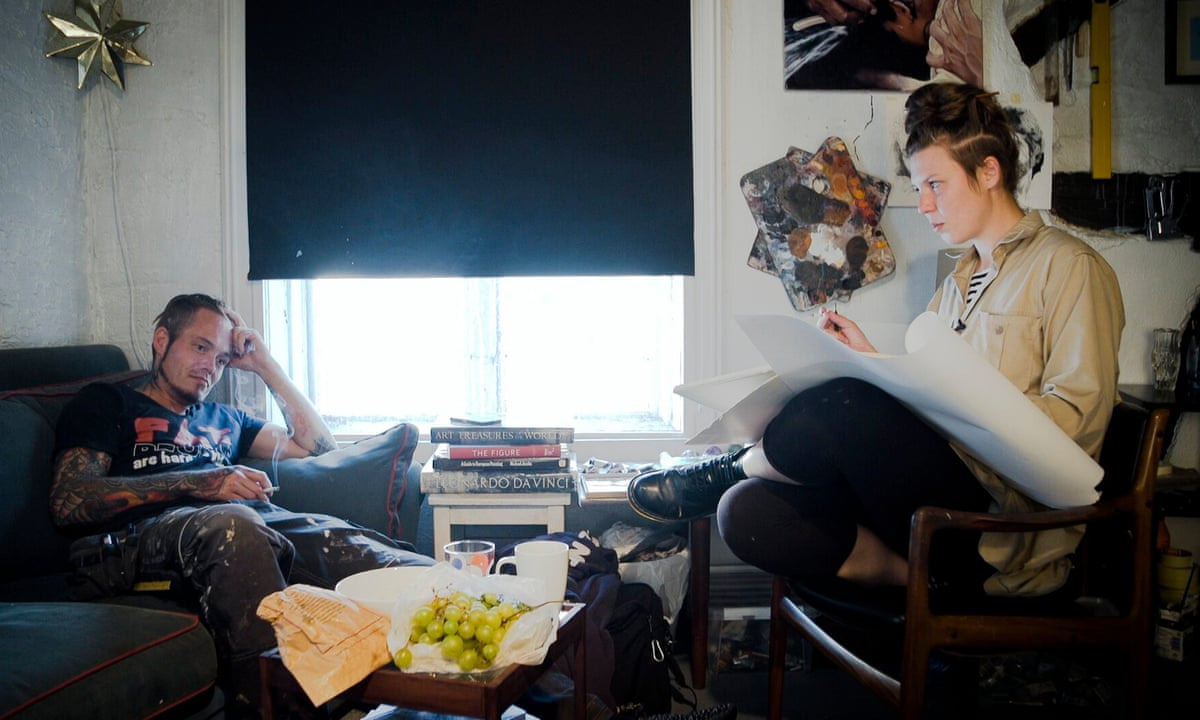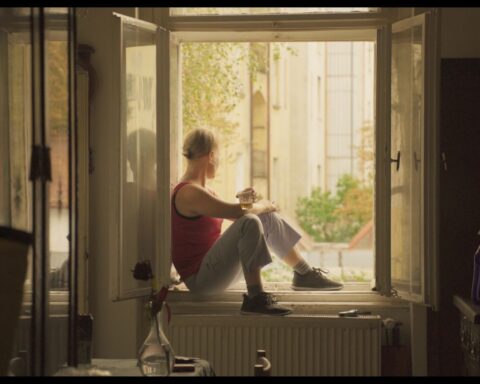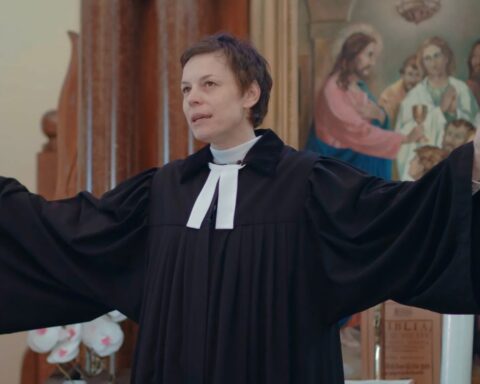The Painter and the Thief was one of the grand documentary successes of this year’s Sundance Film Festival, winning a Special Jury Award for Creative Storytelling and securing a lucrative distribution deal. The story is brilliantly cinematic in its sweep, telling the tale of painter Barbora Kysilkova who finds an improbable muse in Karl Bertil-Nordland, a troubled man with a criminal past who served time for stealing her artwork. Benjamin Ree’s doc follows Nordland’s journey from art thief to artistic subject as Kysilkova asks him to pose for her work. The film shifts perspectives as it unfolds to provide audiences insight into the complexities, strengths, and vulnerabilities of the artist and subject alike. I described the film as “a warm, moving, and often astonishing look at these two remarkable yet deeply flawed individuals” in my Sundance review. The film has grown in my esteem upon repeat viewings.
POV had the chance to speak with Ree over Zoom about his extraordinary film, the journey to bring it to screen, and how it has affected both filmmaker and subject alike since Sundance, prior to its Hot Docs virtual premiere. – Jason Gorber
POV: Jason Gorber
BR: Benjamin Ree
This interview has been edited for brevity and clarity.
POV: Congratulations on the film. I’m excited to see how well it’s been received since its premiere.
BR: Thank you so much. Sundance was a great experience and it was so fun to see Barbora there. She got a standing ovation every time she came onstage and now she’s actually selling paintings because of the film!
POV: How did the story come into your life?
BR: Back in 2016, I was researching art robberies. In Norway, we have a great tradition of art robberies. What fascinates me about the topic is the odd combination: you have art, which is high culture, and you have robbers, who represent low culture. The film’s story was front page news in Norway, and while following the case I learned that the painter had approached the thief in court and asked if she could paint him. It was after that I got in contact with Barbora and Karl Bertil, thinking it was a really fascinating premise for a story.
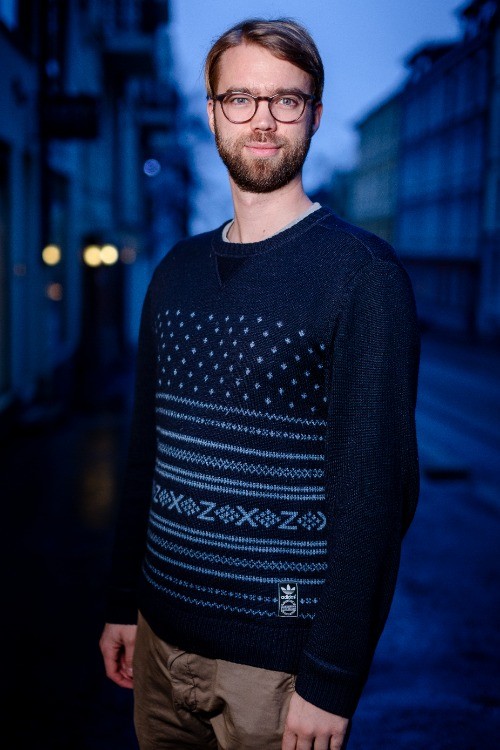
POV: Am I correct in understanding you weren’t the first person to document her story, as there are images of Barbora painting the work before it was stolen?
BR: I was very fortunate because I already had a lot of archival footage. When I began, Karl and Barbora had met about four times. A friend of the artist had filmed her a lot, documenting her art projects, her exhibitions and so on. We also had the courtroom audio recordings, so there was a lot to draw upon before I came along. When I began filming, I thought I was going to make a short ten-minute documentary. I work at an online news network in Norway where I do some short documentaries for TV, and that was what I thought I was doing at the beginning. But after we got the scene where Karl Bertil saw himself painted for the first time, everything changed. I began to realize what kind of story this might be and that it was definitely not going to be a ten-minute documentary.
POV: Have you found that there is a paradigm shift in your methods between doing a narrative that works in a ten-minute package and a feature-length documentary?
BR: I’ve done a lot of short documentaries and I did one feature, Magnus, which premiered at Tribeca in 2016, about Magnus Carlsen, the world’s best chess player. I learned that no one would ever say yes if you went up to them and said, “I want to film you for three years and you have to give hundreds of days up to my disposal.” When you begin filming, you never know what kind of access you will get, and you don’t know what will happen in the lives of these people. The success of Magnus, which is structured as a classic sports documentary, made it possible for me to work with whatever else I wanted to for two years. With Painter, there was a slow transition from thinking it would be ten minutes, then believing it would be a half-hour film that I could sell to the New York Times or the Guardian. Then I went through a period thinking it would be an hour-long commercial film for TV.
It changed over time, but I think that’s actually a good way of doing a documentary. Many of my favourite films started as shorts. If you look at Steve James’s Hoop Dreams, that also started as a thirty-minute documentary for TV, and then it just gradually grew into a bigger project. In psychology, they call it the “foot in the door” technique. If you’re a salesperson with your foot in the door, it’s much easier to convince [a buyer] to [let you] enter their home. I was very fortunate that for this story, so much happened and I got the access.
POV: Now that you mention it, the spirit of Steve James is definitely on display in your film.
BR: I get goose bumps when you say that because he’s a big hero of mine. I can’t mention how many times I’ve watched Hoop Dreams and Stevie with audio commentary tracks!
POV: You employ a kind of “rewind” structure, where we follow one person’s story, then flash back and follow the other participant. It makes the film highly cinematic, but some may also feel it very manipulative. How soon into the project did you realize you were going to use this technique?
BR: My film is made to be discussed in both content and form. We filmed for three years, took eight months to edit, and found the structure in the editing room. We really wanted to portray Bertil as a complex guy, filled with humour and intelligence. We thought that the only way to really show his complexity was to see the world from his point of view. The cliché surrounding films like this appears when you only see their world from the artist’s point of view. When you watch the film, the shift comes as a surprise. Bertil comments at one point that Barbora sees him very well, but she forgets that he sees her too. Usually, the dramaturgic motor of a story is the question about what will happen next. When you jump [around] in time that changes [one’s] perspective, so you question more about why something happened the way it did. Dramaturgy in documentaries is an artistic choice, but it’s also an ethical choice. It allowed us to portray Karl Bertil with empathy and respect.
POV: The challenge is to find the balance and not let the form overwhelm the story.
BR: When I began making observational documentaries, I was shocked by how many ways you can edit a scene. You could take one day’s shoot, maybe two hours of roll, and work with the subtext of the scene, you can do twenty or thirty different takes on it. You might begin with the subject being loneliness and it ends up being about togetherness.
In The Painter and the Thief, we usually had twenty-five to thirty different takes for a single scene and tried out different versions. It’s possible to work a lot with the subtext as film has a language of its own. It differs from written text. This structure allows us to add a meta-perspective to the story. Some reviews are a bit critical of it because they feel it’s a bit manipulative, but the film is made to be discussed. I think that [serves] as an allegory for the film also—when you see a painting or a picture, you really want to feel that it is the truth. It’s what I see. It’s your version of reality. But you have to remember that there is always framing, with things that are kept out of a picture or a painting. This is also what my film is commenting on. There are some subjective choices here, and it’s possible to tell these stories in totally different ways.
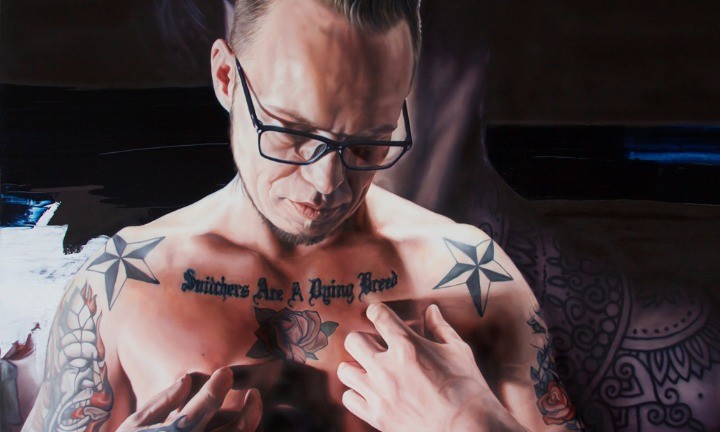
POV: Could you talk about the reaction of the two subjects and at what point in the process you started showing them footage?
BR: I never showed the subjects any footage during filming because I was afraid that they would be too self-conscious and self-aware. When we had the first proper edit of the film, I showed it to them and then they had some comments that made the film better. Since we are portraying their point of view, their comments were like, “Here I felt a bit more uncomfortable when I met him for the first time,” or, “In this scene, the dialogue wasn’t that perfect. We were a bit more insecure.” We could adjust the edit to show what their inner state was in a scene.
Karl Bertil was actually asked the same question by Vanity Fair. I thought it was funny that they’re used to doing interviews for media-prepped celebrities. He said, “It was horrible, horrible! I only watched the film once and I’m never going to watch it again!” I do think it was horrible for Karl Bertil to watch it, but I also know he’s so proud of it, and this is what he wanted for the film. He wanted to show the ugly truth, and this was something we talked about while filming. Barbora was also a bit uncomfortable watching [the film], but it was especially tough for Karl Bertil. At the same time, he feels that he can own his story now more than before, after watching it.
POV: Do you think there’s something unique about Norwegian culture that allows an empathetic understanding of criminal behaviour?
BR: In Norwegian society we are focused on rehabilitation rather than punishment. Look at Halden Prison where we filmed. So many documentaries have been made about it; even Michael Moore went there for his documentary Where to Invade Next. The film shows that in Norwegian society we use a lot of government money to rehabilitate people like Karl Bertil. But look at Bertil today. The government has invested in his life to get him back on his feet, and now he’s ready to give back. He’s been sober for over a year now, and he has finished his second year studying sports medicine. I think that the costs to rehabilitate someone like Karl Bertil are totally worth it when he can get back on his feet, earn his own money, and give back to society.
POV: Do you see your film as having good guys and bad guys?
BR: No, I don’t think so. I hope that we portray these people as much more complex than that.
POV: I ask because it’s easy to be swept up in the joy of their connection and not see the darkness.
BR: I think both Karl Bertil and Barbora display some really serious self-destructive behaviour, and they have traumatic experiences from their past that haunt them today. They deal with it in different ways. Barbora’s escape is painting. When I began this project, I became fascinated by the contrast of the painter and the thief, but towards the end of the three years, I really got to understand that these two people are very much alike.
POV: How has the acclaim shaped your own reaction to the film? You had something that was very intimate and very local, and it is international now.
BR: I have to be honest about this, it’s been very surprising to receive this kind of attention. Working with a project like this, my self-confidence has been like a yo-yo—it has gone up and down. I was very insecure about the film when it was finished [in terms of] how it would resonate with an audience.
POV: Could you be specific about what you were anxious about?
BR: I was very worried about the artistic choices of jumping back and forth in time, and the changing perspectives. I knew we had a good story here, and my nervousness was around how it would play out based on the way we had structured it. Sometimes I was afraid I had destroyed the film using the structure we did. I think that maybe since the reaction has been so positive I can take even bigger chances in my next project.
POV: Can you say what your new project is?
BR: It deals with trauma and memory and it’s about illusionists. More than that, I can’t say at the moment, but it’s a project that will hopefully take even bigger artistic risks!
The Painter and the Thief screened at Hot Docs’ online festival. and is now available on home video.
Visit the POV Hot Docs Hub for more coverage from this year’s festival.




